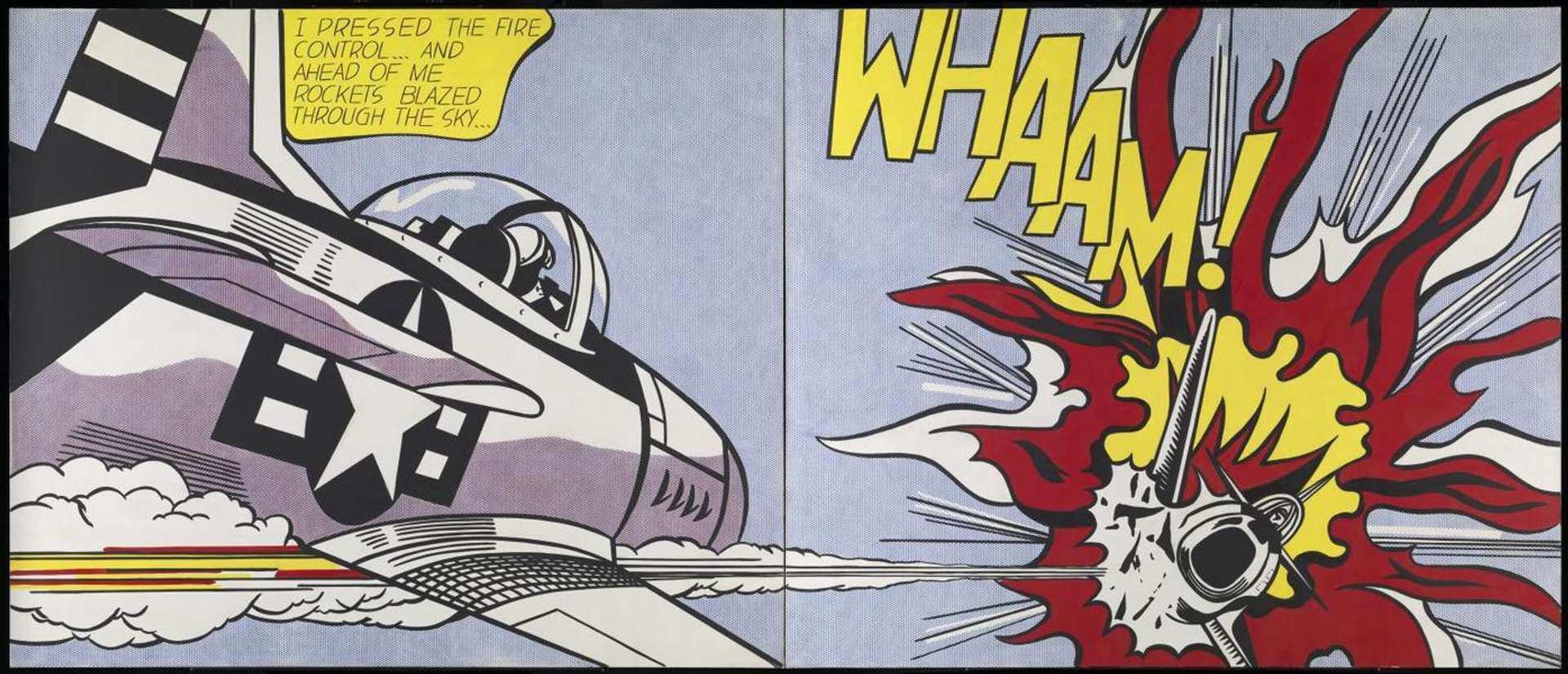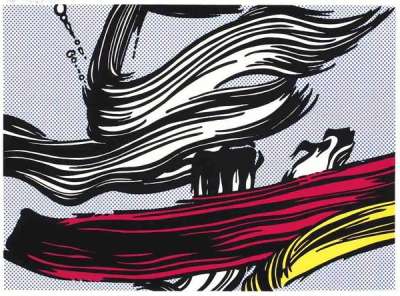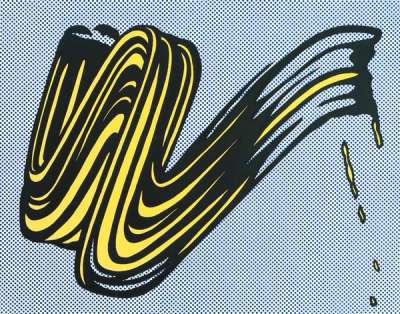 Whaam! © Roy Lichtenstein 1967
Whaam! © Roy Lichtenstein 1967
Rebecca Marsham, Sales Directorrebecca.marsham@myartbroker.com
Interested in buying or selling
an artwork?
If you are in the market to buy a Roy Lichtenstein print, here are a few pieces of advice before you start your search, to make sure you find the right piece at the right price.
According to the legendary art dealer Ivan Karp, “Every artist falters from time to time — except for Roy Lichtenstein.” Put another way, Roy Lichtenstein has the highest batting average of any major artist. His consistency was remarkable. Lichtenstein’s ability to transform virtually any subject into a crisp reductive image, often painted in bright primary colors, assured his place in the art history canon. Beyond his paintings, the highly graphic quality of his imagery was tailor-made for the printmaking process.
Below are some recommendations for acquiring Roy Lichtenstein prints:
The Top Lichtenstein Prints
Unlike Andy Warhol, where the top print editions are obvious, Roy Lichtenstein’s finest graphics are less so because of their high level of consistency — there are plenty to choose from.
Print collectors have often sought out two early Lichtenstein silkscreens from 1965: Reverie and Sweet Dreams Baby! Both are great examples of Pop art and bear a close connection to the artist’s classic sixties canvases. Besides the fact they’re expensive — and can run six-figures — these prints should be avoided by all but seasoned collectors. The main issue is condition. Since they were released so long ago, back when Lichtenstein and the rest of the key Pop artists had little value, many of these impressions are now faded. Most collectors simply didn’t take very good care of them. The problem with a print that’s “light struck” is it can’t really be restored. But that hasn’t stopped owners from trying. A fair number of copies of each print have been “re-screened.” Our advice is to stay away from these impressions — no matter how tempting the price. If you are insistent on acquiring a copy of Sweet Dreams Baby! or Reverie, be sure and have it examined by a conservation expert. Also beware of forgeries — both prints have been counterfeited. (Note: The related offset lithographs, Crak! and Crying Girl (both from 1963) are also known to have condition and authenticity issues.)
As for the rest of Lichtenstein’s vast print oeuvre, there are many high-quality examples to consider. Interestingly enough, Lichtenstein became a better print maker as time went on. Much of this can be attributed to his collaboration with Kenneth Tyler of Tyler Graphics. The Tyler workshop took Lichtenstein’s prints to the next level — in terms of scale, ambition, and quality. Many of the large-scale prints produced by Gemini were also of a high order.
A complete set of the Bull Profile Series (Bull I-V) is worth acquiring — but only if you can hang the whole set on a long continuous wall. Otherwise, something seems to get lost in the translation. If you have the wall space, the Interior Series is outstanding and worth pursuing. The standouts are those prints which reference works by Andy Warhol — which become “art about art.”
The Top Lichtenstein Prints
Still Life with Lobster (1974)
Blonde (1978)
Two Paintings: Sleeping Muse (1984)
Two Paintings: Beach Ball (1984)
Two Paintings (1984)
The Sower (1985)
View from the Window (1985)
Reflections on Crash (1990)
Reflections on Minerva (1990)
Reflections on Girl (1990)
Modern Room (1990)
Yellow Vase (1990)
Les Nympheas (1993)
Water Lily (1993)
 Nurse © Roy Lichtenstein
Nurse © Roy LichtensteinUndervalued Lichtenstein Prints
The real sleeper in Lichtenstein’s print oeuvre is the Mirror Series (1972), which consists of ten images. For years, Lichtenstein’s mirror paintings were overlooked by the art market. Not surprisingly, Andy Warhol was one of the early buyers. His upper East Side townhouse in New York displayed a circular Mirror canvas exquisitely installed above the mantel of the fireplace. A mirror has to be one of the most challenging objects for an artist to paint. Intellectually, it becomes a metaphor for the viewer to see himself and project onto the work whatever he chooses. Lichtenstein’s creative genius found a way to distort how light bounces off a mirror’s reflective surface, distilling it to its essence of handsome abstract forms and colors. This is one series where the viewer will never see the same thing twice.
Additional Undervalued Lichtenstein Prints
Sunrise (1965)
Modern Art Poster (1967)
Entablature Series (1976)
American Indian Theme Series (1980)
Experimental Lichtenstein Prints
At the beginning of the 1990s, Roy Lichtenstein began working with the publisher Donald Saff of Saff Tech Arts, and produced the “Water Lilies Series” (1992), derived from Claude Monet’s classic “Water Lilies.” Their collaborative efforts yielded a group of enamel on “swirled” stainless steel prints. The unconventional materials pushed the boundaries of what can be considered an original print. The far less expensive Les Nympheas and Water Lilies may be preferable here, which each portray the same subject.
Just Say “No” Lichtenstein Prints
In 1969, perhaps due to a desire to comment on the “Op Art” movement, Roy Lichtenstein produced two series which “re-interpreted” Monet’s famous Haystacks and Rouen Cathedral. Neither series succeeded. In each case, thanks to the dominance of Lichtenstein’s trademark Ben-Day dots, the subject took a backseat to the technique. In reference to the Brushstroke Figures Series, the images became a mish-mosh of abstract brushstrokes and facial features — so much so that they became caricatures of a Roy Lichtenstein.
Reference Materials for Making Informed Decisions
The Roy Lichtenstein print “bible” is The Prints of Roy Lichtenstein: A Catalogue Raisonné 1948-1997. No other reference source comes close to illustrating the complete prints of Lichtenstein, along with pertinent data about each individual print. There’s also a good introductory essay, by the curator Ruth E. Fine, which places these works in context of the greater art world. Unfortunately, the second edition of the catalogue (which is the most useful) is out of print, hard to find, and expensive. Roy Lichtenstein fans will also enjoy the Guggenheim Museum exhibition catalog Roy Lichtenstein by Diane Waldman and Roy Lichtenstein A Retrospective by James Rondeau and Sheena Wagstaff. Both are chock full of large color reproductions of many of his most important paintings.
For authentication on your Roy Lichtenstein print see Richard Polsky Art Authentication, which specializes in authenticating the work of: Andy Warhol, Jean-Michel Basquiat, Keith Haring, Roy Lichtenstein, and others: www.RichardPolskyart.com















